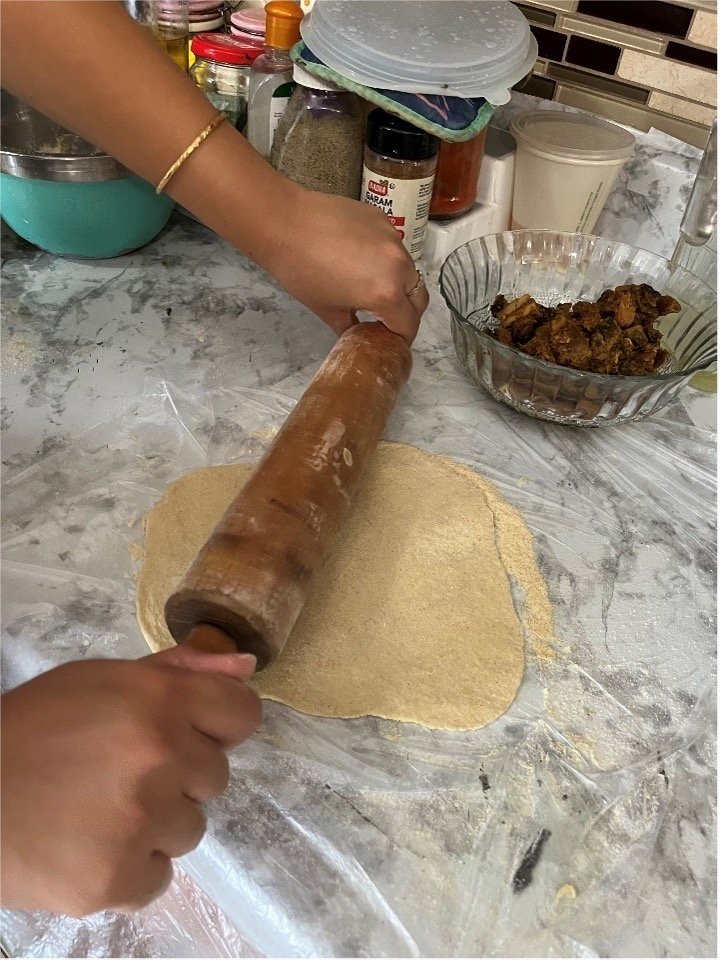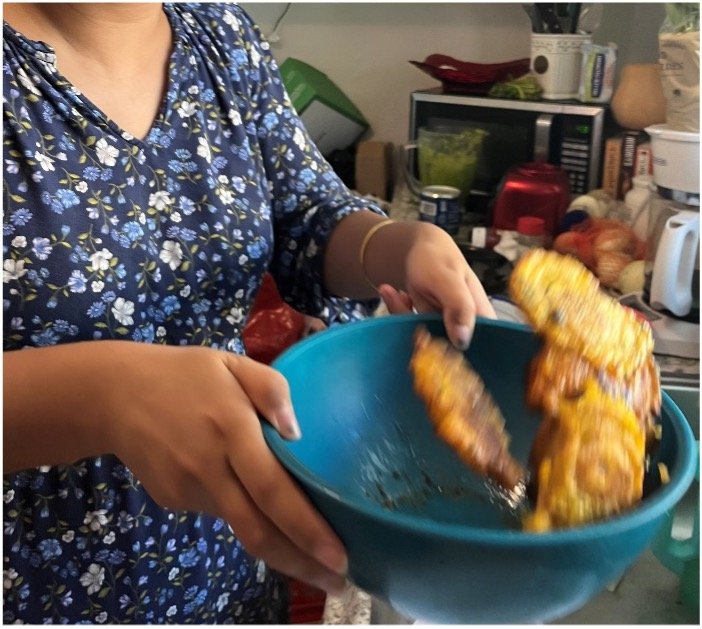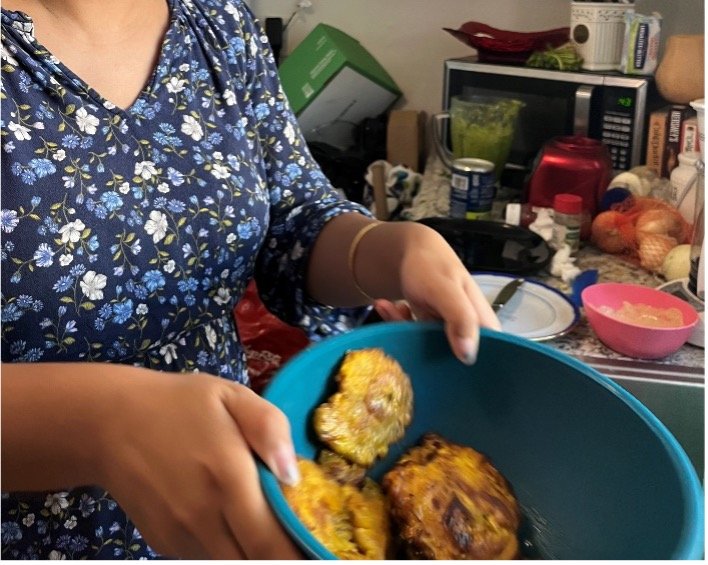This post is part of PwintPhyu Nandar’s 2023 Global Food Fellowship.
As I write this, I’m sitting at home in Richmond, California, with my maternal grandmother, who is visiting form Myanmar (Burma). We had spent this morning soaking ocean snails, along with two varieties of seaweed. A few moments ago, we were cleaning the snails to prepare them for tomorrow’s salad. While at home with my grandmother, I’ve helped her pick limes and pea eggplants growing in the front yard. In the back garden, I helped my mom trim back pennywort so it would grow back stronger in its recycling bin home.
Pennywort (above) and pea eggplants (below) from my family’s garden.
These moments are just a few that inspired me to ask how people access their cultural foods in urbanized areas. When I moved away from home to Los Angeles, there were ethnic markets abound, but not ones that carried my favorite vegetable or the correct brand of vermicelli noodles, and especially not ones that were within a few minutes’ drive instead of an hour. In New Haven, I was surprised to live close to Korean, Mexican, and Chinese grocery stores, but unsurprised to see a diverse customer base frequenting them. These experiences helped me formulate my two main questions, serving as the basis of my master’s thesis: (1) what cultural foodways exist in an urban area, specifically Greater New Haven, Connecticut, and (2) how individuals navigate these foodways.
To answer these questions I collected surveys, but most exciting to me, I also asked Greater New Haven residents to take me with them as they make their cultural meal. As such, I’ve visited ethnic markets in the area, such as Indian Farmers Market in Orange, International Market in Bridgeport, G Mart in Milford, and Key Foods (formerly C-Town Town) in Fairhaven. I’ve also visited markets that may seem like they don’t provide cultural foods but do in fact have the necessary ingredients for a cultural meal. These include mainline grocery stores, such as various Stop & Shops, ShopRites, and Aldis, but also organic food stores, such as Edgewood Market in Edgewood (where else, of course?), and Thyme & Season in Hamden. Residents I cooked with showed me their gardens or told me of their families’ garden. When I’m volunteering at the food bank, farmer’s markets, or at an urban farm, fellow volunteers will talk to me about how they share their cultural ingredients and meals with their friends or family.
View of International Farmers Market in Bridgeport from the parking lot.
In this section of International Farmers Market, you can choose the fish you want to buy. My research participant told me to look for fresh fish with round eyes, as opposed to fish with flat eyes.
I’ve also had many a conversation with fellow volunteers and my research participants about how they find themselves at Chinese or Asian grocery stores despite not being Chinese or Asian themselves. I want to make note of these conversations, because it reflects my observations at ethnic markets across Greater New Haven. Whether they may or may not be labeled as catering to a specific population (Indian Farmers Market for example), I’ve noticed these markets serve a diverse clientele, as I and the residents I go with to these stores may not necessarily belong to the population the market supposedly caters to. I’ve gone to the Indian Farmers Market with a Pakistani family. Asia, Africa, and Latin America, for example, are all large continents with a variety of different cultures. So, it’s only fair to say that ethnic markets do not serve monolithic populations, but rather diverse cultures from within the same continent, and across multiple continents. I’ve gone to G-Mart, an Asian market, with a Korean resident, as well as with a Chinese-Vietnamese resident with their Puerto Rican partner. Unsurprisingly, the cultural foodways in Greater New Haven are just as diverse as those who call this metropolitan area their home.
To be literal about my second question regarding how individuals navigate their foodways, there are a variety of ways for Greater New Haven residents to get to their cultural foods and back—driving, biking, taking the bus, or even walking. What I’ve found most important to this navigation and what surprised me the most was access to knowledge. Access to cultural food and access to knowledge are inextricably intertwined. One must know where to go to gather their ingredients (or sometimes who to go to), but more importantly, one must know what ingredients are needed and what to do with them once home from the grocery store, local urban garden, or the farmer’s market. There seems to be a gendered aspect to this knowledge, that I’m excited to delve deeper during my analysis, especially surrounding who passes down the knowledge of how to cook.
Speaking of knowledge, I would not have learned any of this over the summer if it wasn’t for the kindness of Greater New Haven residents. Those I’ve cooked with welcomed a stranger into their homes, let me drive with them to their favorite store, and taught me how to cook a meal that was dear to their heart. They opened up to me, shared stories about their families, and patiently answered my questions over chopping vegetables and spoonfuls of food.



I want to leave off with an anecdote from my first day of volunteering with an urban farm’s wellness program. I walked about two miles to where I thought was the correct location and met a stranger dissembling a structure meant for compost. Not seeing anyone else, I go up to the man to ask where everyone was. He let me know I was probably in the wrong location and after introducing ourselves to each other and telling him about my research, he offered to take me to the right place. Of course, I was hesitant to get into a stranger’s car, but there was a fatherly aura about this man and he seemed more worried about me than anything else. Once in the car, we swap stories about our cultural foods and he stops in front of Key Foods. He insists on buying me ice cream at the little cart called Catch the Flava. The ice cream there is the closest to what he grew up eating in Venezuela, where it was made with a hand-cranked shaved ice machine. “It’s the best ice cream in Connecticut,” he insists. And when I eat it, I’m inclined to believe him. After this stop, it ended up being only a short drive to the correct location. He drops me off, telling me to be careful, and I scamper off with coconut and passionfruit ice cream in hand.
This is the urban garden I was supposed to head to. When I took this picture, later in the summer, it had just rained, so everything is lush and green.
This was one stranger’s kindness, but as I mentioned before, my whole summer was flavored with kindness, week after week. When I do finally draft my thesis, I hope to return the favor by reflecting the care and love I experienced this summer in my writing.
(I am grateful for the Global Food Fellowship, the Mobley Family Environmental Humanities Summer Student Research Grant, and the Williams Internship Fund for supporting my research. Additionally, I would like to acknowledge and thank the following organizations for having me as a volunteer: CitySeed’s Famer Markets, CitySeed’s Sanctuary Kitchen, Gather New Haven’s Farm-Based Wellness Program, and Loaves & Fishes. Lastly, this research could not have been possible without the guidance of my advisor, Dr. Dorceta Taylor.)




